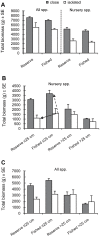Effects of marine reserves versus nursery habitat availability on structure of reef fish communities
- PMID: 22675474
- PMCID: PMC3366965
- DOI: 10.1371/journal.pone.0036906
Effects of marine reserves versus nursery habitat availability on structure of reef fish communities
Abstract
No-take marine fishery reserves sustain commercial stocks by acting as buffers against overexploitation and enhancing fishery catches in adjacent areas through spillover. Likewise, nursery habitats such as mangroves enhance populations of some species in adjacent habitats. However, there is lack of understanding of the magnitude of stock enhancement and the effects on community structure when both protection from fishing and access to nurseries concurrently act as drivers of fish population dynamics. In this study we test the separate as well as interactive effects of marine reserves and nursery habitat proximity on structure and abundance of coral reef fish communities. Reserves had no effect on fish community composition, while proximity to nursery habitat only had a significant effect on community structure of species that use mangroves or seagrass beds as nurseries. In terms of reef fish biomass, proximity to nursery habitat by far outweighed (biomass 249% higher than that in areas with no nursery access) the effects of protection from fishing in reserves (biomass 21% lower than non-reserve areas) for small nursery fish (≤ 25 cm total length). For large-bodied individuals of nursery species (>25 cm total length), an additive effect was present for these two factors, although fish benefited more from fishing protection (203% higher biomass) than from proximity to nurseries (139% higher). The magnitude of elevated biomass for small fish on coral reefs due to proximity to nurseries was such that nursery habitats seem able to overrule the usually positive effects on fish biomass by reef reserves. As a result, conservation of nursery habitats gains importance and more consideration should be given to the ecological processes that occur along nursery-reef boundaries that connect neighboring ecosystems.
Conflict of interest statement
Figures



References
-
- Stone R. A world without corals? Science. 2007;316:678–681. - PubMed
-
- Hughes TP, Baird AH, Bellwood DR, Card M, Connolly SR, et al. Climate change, human impacts, and the resilience of coral reefs. Science. 2003;301:929–933. - PubMed
-
- Newton K, Cote IM, Pilling GM, Jennings S, Dulvy NK. Current and future sustainability of island coral reef fisheries. Curr Biol. 2007;17:655–658. - PubMed
-
- Jackson JBC, Kirby MX, Berger WH, Bjorndal KA, Botsford LW, et al. Historical overfishing and the recent collapse of coastal ecosystems. Science. 2001;293:629–638. - PubMed
-
- Bellwood DR, Hughes TP, Folke C, Nystrom M. Confronting the coral reef crisis. Nature. 2004;429:827–833. - PubMed
Publication types
MeSH terms
LinkOut - more resources
Full Text Sources
Research Materials

